

Saturn peaches, Pluto plums bring space-inspired stone fruit to supermarket shelves. Space-inspired stone fruit will grace supermarket shelves this season after Australia's largest family-run grower, packer and marketer spent more than a decade identifying new varieties.

Key points: This summer, Cutri Fruit will be increasing sales of unusual-looking stone fruit in supermarkets40,000 punnets of flat Saturn peaches were sold in Coles supermarkets last yearFurther fruit varieties are expected to be added to the range in the coming years Cutri Fruit at Woorinen near Swan Hill launched its Galaxy Fruits range last summer, starting with a flat peach called Saturn. It was 15 years ago when the company's CEO, Gaethan Cutri, stumbled across the Saturn peach in Spain. He said they were popular with consumers because they were flavoursome and did not go soft too quickly. "When most people go on holiday they go and relax. "The first time consumers taste them, I think they'll be pleasantly surprised, and maybe they'll actively seek them out after that," Mr Cutri said. Tallulah Moon's family raises money for research into hereditary spastic paraplegia type 56.
Tallulah Moon was 14 months old and beginning to walk and talk — when suddenly her laughter and dancing stopped.
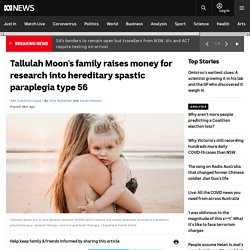
Her legs stiffened, and when her previously confident stride faltered she reverted back to crawling. Her parents were distraught and at a loss. Hope for damaged parts of Great Barrier Reef as tourism sector helps deploy millions of coral 'babies' Plumes of tiny white particles fall like underwater snow over the remnants of this reef.

It is the first sign of new coral life here in years. Once a vibrant expanse of underwater colour, this site on the Great Barrier Reef was obliterated during a severe tropical cyclone nearly five years ago. Now, a team of researchers and tour guides is floating on the surface above the reef. Armed with a few boats, special pontoon structures and some patience, they're confident it can be revived. Southern right whale satellite tagging project blows migration assumptions out of water. It has long been thought that the majestic and peaceful southern right whale headed south to Antarctica after frequenting Australia's coast and the Auckland Islands south of New Zealand each winter.
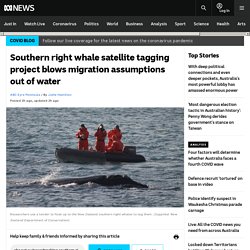
New Zealand southern right whales once numbered about 30,000 but whaling saw them drop to just 40 in the 1920sA satellite tracking program followed the whales' migration west to below Australia, breaking myths they head south or east from traditional breeding groundsThe international research program is assessing the impact of climate change on the whales But is that where they really go? Until now, the whales' movements away from the breeding grounds have largely been a guessing game. A two-year international research project, called Tohora Voyages, tagged six New Zealand southern right whales (Eubalaena australis) in 2020 and 11 more this August, to help assess the impact of climate change on the species.
The results have been myth-busting. "And so that in itself is surprising. Canberra engineer helps develop 'game-changer' iodine electric propulsion system for satellites. A Canberra-based engineer has helped develop a world-first propulsion system hoped to better allow satellites to dodge space junk.

Key points: A Paris-based company has developed a propulsion system that uses iodine instead of xenonSpacecrafts require propulsion systems to perform orbit transfers, avoid collisions, and for end-of-life disposalThe iodine system was successfully tested in orbit in November last year For decades, space agencies have been searching for an alternative propulsion system to electrical ion engines powered by xenon gas, which is expensive, heavy and rare.
Researcher works to ease side effects like GVHD that plague bone marrow transplant patients. David White felt like a million mosquitoes were biting his face.
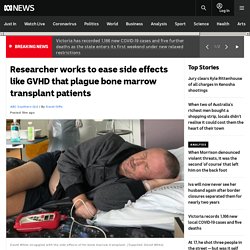
Key points: Siok Tey hopes to improve transplant outcomes and eliminate serious side effectsHer research focuses on developing ways to select good cells for use in transplantationShe hopes to potentially create cancer-killing cells through cell and gene technology The 52-year-old sculptor from Nanango was being treated for acute myeloid leukaemia (AML), a form of bone cancer. He recalls lying in his bed at the Royal Brisbane Hospital in the middle of the night, crying because the itch was intense.
He later learned the sensation was one of the harmful side effects that can follow a bone marrow transplant and was caused by some of the donor cells attacking his healthy tissues. The first 100 days after a transplant are the acute stage, during which patients can have adverse immune responses to the new blood cells introduced to their system. Forty per cent will experience chronic cases. Mushrooms trained to 'eat' cigarette butts to tackle one of world's biggest litter woes. Scientists around the world are discovering many environmental uses for fungi, and now Australian researchers are hoping oyster mushrooms will solve one of the world's biggest litter problems — what to do with the 4.5 trillion cigarette butts tossed away every year.
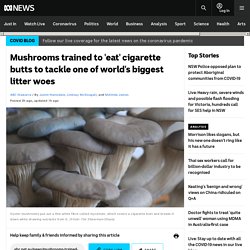
Key points: Oyster mushrooms are being trained to feast on cigarette butts to break down their microplastics and create a reusable productIn an Australian first, Wollongong City Council will partner with researchers to address the waste issueCigarette butts are one of the world's biggest litter problems, with 4.5 trillion butts discarded into the environment every year The key, according to fungi researcher Amanda Morgan, is convincing oyster mushrooms that cigarette butts are edible. Scientists create new type of eco-glitter made from biodegradable, sustainable materials. Glitter is used everywhere from kids' craft projects to cosmetics, but beneath its shiny surface is a dark side.
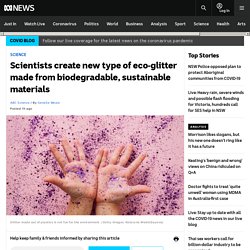
Key points: Traditional glitter is made of plastic, and while there are some eco-glitters on the market they are not fully made out of plant materialsNow UK researchers have made a new type of glitter made out of a cellulose nanomaterial they say is truly biodegradableIt is the first time that they have been able to produce the glitter on a commercial scale Beyond being annoying like a party guest that refuses to go home, these tiny sparkles are traditionally made of plastic and contribute to pollution. As a result, scientists have called for it to be banned, and it's no longer used by organisations such as the Sydney Gay and Lesbian Mardi Gras. But there may be an alternative in the future with the creation of a new nanomaterial inspired by nature. Touchless crossing button trials in Melbourne CBD and Kingston Council 'successful' so far with international interest.
The pandemic has changed the way we press a crossing button – instead of using our hands, a jutted-out elbow or a raised foot has done the trick.
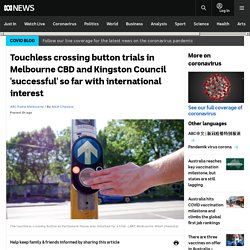
Key points: Touchless crossing buttons have been installed for trial in Melbourne's CBD and the Kingston Council areaThey were installed in response to the COVID-19 pandemicIf successful, the Victorian Department of Transport will look to roll them out across thousands of crossings statewide. The Montreal Protocol — a climate change success story to remember amid the gloom of COP26. As COP26 enters its second week without much sign of progress, despair is in the air.
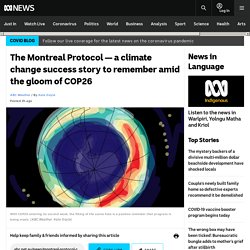
But before you give up all hope, there is a shining example of when one of these global talkfests actually succeeded — the Montreal Protocol to the Vienna Convention for the Protection of the Ozone Layer. Despite a few wobbles along the way, the protocol has protected us from harmful UV rays, while also helping to reduce global warming on the side. This is the story of how it can be done. Technology set to redesign the future of food as agriculture moves towards net zero.
On the east coast of Tasmania, the frigid waters and green landscape seem a world away from the blistering heat and red dirt of Western Australia's Pilbara. Key points: Australia's farming industry has committed to reaching carbon neutrality by 2050Agriculture accounts for about 13 per cent of Australia's greenhouse gas emissionsProtein demand is tipped to rise 74 per cent by 2050 as the global population heads towards 10 billion But the two regions, on opposite corners of the Australian continent, are being brought together in surprising ways.
Scientists have found that a red seaweed known as asparagopsis, native to Tasmania, can cut the methane emissions from cows by up to 98 per cent when added to their diets. Queensland researchers create functioning brain tissue in lab from blood of epilepsy patients to tailor treatments. Queensland researchers have turned blood samples from epilepsy patients into functioning human brain tissue, allowing them to test the effectiveness of different combinations of anti-seizure drugs. UQ researchers have created functioning brain tissue dubbed "organoids"This can be used to develop epilepsy treatment tailored to individualsEpilepsy expert Professor Harry McConnell says the research is potentially a game-changer University of Queensland (UQ) scientist Ernst Wolvetang hopes the novel approach will take the guesswork out of prescribing seizure drugs to epilepsy patients, a process that is often a long journey of trial and error for neurologists.
About a third of people with epilepsy never achieve effective seizure control. Professor Wolvetang's team at UQ's Australian Institute for Bioengineering and Nanotechnology has created human brain tissue in a petri dish. It produces electrical activity and mimics human brain waves. Malaysian gynaecologist invents world's first unisex condom using wound-dressing material. A Malaysian gynaecologist has created what he says is the world's first unisex condom that can be worn by females or males, made from a medical-grade material usually used as a dressing for injuries and wounds.
John Tang Ing Ching says the unisex condom will empower people to take better control of their sexual healthThe condom has an adhesive covering that attaches to the vagina or penis, allowing both sexes to use itEach box of the new product will cost just over $4 Its inventor — John Tang Ing Ching, a gynaecologist at medical supplies firm Twin Catalyst — hopes his Wondaleaf unisex condom will empower people to take better control of their sexual health, regardless of their sex or sexual orientation. "It's a condom with an adhesive covering that attaches to the vagina or penis, as well as covering the adjacent area for extra protection," Dr Tang said.
The adhesive is only applied to one side of the condom, he added, meaning it can be reversed and used by either sex. Composite glass breakthrough by Queensland researchers could help make phone screens 'unbreakable' Australians destroy or lose more than 1,300 smartphones a day, with cracked and shattered screens the most common way of damaging them. The researchers have developed a composite glass that is practically unbreakableEngineer Jingwei Hou says it could also turn phone screens into mini solar panelsIt will also have applications TVs, computers and virtual reality They have forked out a staggering $755 million each year over a five-year period to fix them, according to data from the comparison website Finder.
Now, thanks to a crack team of scientists at the University of Queensland working with researchers across the world, smashed phone screens could become a thing of the past. The team has unlocked technology to produce the next-generation of composite glass used in smart phones, televisions, computers and even LED lights. Chemical engineer Jingwei Hou said the findings would enable the manufacture of glass screens that are both unbreakable and deliver crystal clear image quality. Clever Parkinson's treatment now allows doctors to manipulate brains from 'anywhere in the world' World-first wireless technology being pioneered in Queensland is allowing specialists to adjust life-changing brain implants from anywhere in the country — and potentially the world – opening new treatment opportunities for Parkinson's patients.
Key points: Wireless technology allows specialists to adjust Parkinson's patients brain implants remotelyDBS implants reduce symptoms of neurological disorders but need to be adjusted by specialists, meaning regular travel for patientsScientists say the new development is a breakthrough that will provide new opportunities and reduce treatment costs For 70-year-old patient Clive Couperthwaite, the development marks the end of a two-hour commute to Brisbane for a 20-minute adjustment to his Deep Brain Stimulation (DBS) device.
Mr Couperthwaite credits the device as the source of his autonomy, calling it a "miracle" as he holds his hands steadily out in front of him. Kimberley mother-of-pearl could become synthetic bone in world-first medical collaboration. Queensland doctors deliver 'life-changing' brain operation on 'brave' epileptic man while he was fully conscious. Doctors at a Brisbane hospital have successfully performed groundbreaking brain surgery on a "brave" young man with epilepsy while he was fully conscious. Key points: Ben Tondeleir had suffered up to 15 seizures a day since the age of sixIn a first for Queensland, brain surgery was performed on the epilepsy patient while he was fully consciousMr Tondeleir says his life has "changed forever" and he now has hope for his future.
Scientists scour Australian rivers in canoes looking for new varities of taro, the 'food of the gods' that's threatened by climate change. A team of Queensland scientists have traded their lab coats for paddles and canoes, as they scour the Brisbane River in search of "the food of the gods". From Lego to US army prototype — Gold Coast inventor wows billion-dollar industry. Cannabidiol: What is CBD, how does it work, and what are the risks? Cannabidiol, also known as CBD, appears to be having a real moment in the sun. Waste oyster shells getting a second life after being recycled to create artificial reefs. Discarded oyster shells from restaurants, usually destined for landfill, are being recycled to create shellfish reefs in Queensland's Moreton Bay. Key points: Oyster reefs, like coral reefs, provide structures where marine plants and animals can liveOyster shells often end up in landfill because they do not decompose and cannot be compostedThe Billion Oyster Project claims to have restored 47 million live oysters.
Melbourne man receives new heart in Alfred Hospital's world-record breaking transplant. 'Life-changing' bionic voice box and an artificial pancreas being developed in Queensland. Innovators in Queensland are keeping busy during the pandemic, working on medical technology that could help change lives. The Barcaldine brothers' journey to a renewable energy precinct planned for outback Queensland. Worcestershire sauce business booms after couple tests recipe on 'fussy family' The smell of delicious spices and secret ingredients surround Bronwyn and Mark Welbeloved's timber home in the middle of the Queensland bush. The couple, who produce a craft-brewed Worcestershire sauce from the cookhouse on their property, admits their business has taken over every corner of their house.
NSW Bushfire Hub, Indigenous language research and school girls win Eureka science prizes. New Australian-first gene therapy gives Rylee and Saman sight at night — and the chance at a new life. Melbourne clinical trial looks at Transcranial Magnetic Stimulation to treat OCD. An 11-year-old's idea to sell 'Billy button' flowers from her family's NSW farm goes viral. Hopes for bioreactor innovation to drive sustainable farming, protect oldest New South Wales marine park. COVID pandemic has a silver lining for local manufacturing as customers turn to Australian made. Cane toad tadpole bait to launch as toxic pests' breeding season heats up. Former Illawarra student turned Canva executive reflects on global tech company's success. Australian technology start-up creates world's most efficient solar cell while replacing silver with copper. Hopes a new eco-friendly concrete can rise from the ashes of coal power.
Batteries of the future set to be cheaper and better — just by adding sugar. World-first research from the University of Queensland hopes to cure cancer, solve obesity using 'plant medicine' Why viral infections are so hard to cure, and how antivirals like COVID-19 drug remdesivir work. Climate change solution could come from 'electrifying everything', Australian inventor Saul Griffith says. Australian farmers and scientists trial new methods to improve soil moisture. Wireless charging room powers your devices without plugs or cables. COVID-proof businesses: Food trucks, exclusive 'appointment' dining, tech support and self care.
Australian research puts larger and more powerful quantum computers within reach. Bettongs, bilbies and the frontline of scientific research for women in Australia. Low GI sugar that helps fight obesity, diabetes now a United Nations award winner. Stand-up comedy 'written by bots' is still one big joke. Artificial intelligence can now be recognised as an inventor after historic Australian court decision.
How Stu Hartley became the 'mad mushroom man' of Old Bar in just four years. Cancer: A story of hope. Going grey too early? New research finds reducing stress may reverse that silvering. Newcastle team develops world-first lickable diabetes test, rendering finger pricks obsolete. Cancer treatment developed by Victorian scientists stops coronavirus replicating in cells. Canberra scientists creating fat from microorganisms to add flavour and texture to plant-based foods. Melbourne lab develops product hoped to save lives of thousands of new mothers.
Breakthrough may treat sepsis, extensive burns, acute respiratory distress. Ancient Indigenous knowledge the key to turning pest trees into essential oil business. Coffs Harbour council vision to install 76 rescue tube at beaches by 2024. Coronavirus epidemic broke out in East Asia around 25,000 years ago, gene study shows. Soil carbon scientists explore fungi to enlist crop farmers in battle against climate change.
Mysterious spinifex grass rings of the Australian outback may be caused by microbes. NASA extracts breathable oxygen from Mars' atmosphere in step towards letting astronauts 'live off the land' Sydney student helps solve quantum computing problem with simple modification. Deep-sea reef study in the 'twilight zone' could uncover key lessons in conservation. How 'agromining' — farming plants that contain metal — could help power the future. 'Haptic feedback' virtual reality Teslasuit can simulate everything from a bullet to a hug.
Fixing climate change, poverty and ocean plastic requires a 'Moonshot' approach, economist Mariana Mazzucato says. Coronavirus 'long haulers' feared they would never recover. Then they got the vaccine. Australian aphrodisiac honey from Phoenix palm creates buzz in Middle East. Campervan renovators are riding high in an era of domestic holidays. Sea slugs can remove their heads and regrow their bodies, scientists discover.
Funnel-web spider venom may one day help save the lives of heart transplant patients. Is asparagopsis seaweed a key way to reduce methane emissions in sheep and cattle, or a risky investment? Crowded stage: Brisbane's Accomplice Collective finds a fluid groove through improv shows. University of Queensland student developing AI-assisted robotic prosthetic. Macadamia nut 'trampolines' a potential game changer for the industry. Innovative agricultural robots land $4.5 million in funding for start-up SwarmFarm. How Veena Sahajwalla's 'green ceramics' made from glass and clothes are revolutionising manufacturing. AI technology helps protect sea turtle nests from feral pigs in north Queensland. Handcrafted sandboards a success for 11yo budding tycoon and third-generation board maker.
From Belgium to Coonalpyn, migrant couple's 'wild ride' story of success in land Down Under. Andrew Forrest on how green hydrogen offers a chance to fix our climate and our economy. COVID is changing everyday design as outdoor dining, hygiene and work-from-home dominates. Sober lifestyle grows in popularity, with more Australians giving up alcohol. The mother and daughter behind Darwin's only African hair salon. Meet the creepy critters of the Southern Ocean's 'twilight zone' Phage therapy offers hope in fight against antibiotic resistance and superbugs. Adelaide scientists turn marine microalgae into 'superfoods' to substitute animal proteins. Designers create modified face masks for people with beards, turbans and headscarves. Drones count koalas faster and cheaper than manual spotting methods: study. Could a common antidepressant help some men deal with their domestic violence?
Chinese volunteers use flamethrower drone to eradicate wasp nests in village near Chongqing - ABC News. How forensic science solved an outback mystery. The new laws of robotics — building on Asimov's science fiction legacy in the age of AI - ABC News. Coronavirus has meant a massive boom in telehealth — one Australian start-up was ready - ABC News. Scientists discover 100-million-year-old bacteria under South Pacific seafloor - ABC News. Coronavirus pandemic sees Australian manufacturing partnership make cheaper ventilator in four weeks.
Indigenous scientists are connecting culture with science to get kids inspired - Science - ABC News. Nuclear fusion promises a clean, green energy future — but there's a catch. The hunt for hydroxyl radicals in Antarctica could reveal the secrets of our future climate. Australian doctors design and make life-saving equipment needed for coronavirus pandemic.